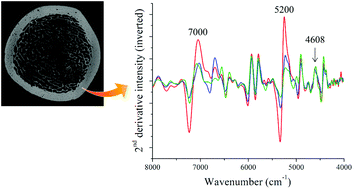Near infrared spectroscopic assessment of loosely and tightly bound cortical bone water
Abstract
Water is an important component of bone and plays a key role in its mechanical and structural integrity. Water molecules in bone are present in different locations, including loosely or tightly bound to the matrix and/or mineral (biological apatite) phases. Identification of water location and interactions with matrix components impact bone function but have been challenging to assess. Here, we used near infrared (NIR) spectroscopy to identify loosely and tightly bound water present in cortical bone. In hydrated samples, NIR spectra have two primary water absorption bands at frequencies of ∼5200 and 7000 cm−1. Using lyophilization and hydrogen–deuterium exchange assays, we showed that these absorption bands are primarily associated with loosely bound bone water. Using further demineralization assays, thermal denaturation, and comparison to standards, we found that these absorption bands have underlying components associated with water molecules tightly bound to bone. In dehydrated samples, the peak at ∼5200 cm−1 was assigned to a combination of water tightly bound to collagen and to mineral, whereas the peak at 7000 cm−1 was exclusively associated with tightly bound mineral water. We also found significant positive correlations between the NIR mineral absorption bands and the mineral content as determined by an established mid infrared spectroscopic parameter, phosphate/amide I. Moreover, the NIR water data showed correlation trends with tissue mineral density (TMD) in cortical bone tissues. These observations reveal the ability of NIR spectroscopy to non-destructively identify loosely and tightly bound water in bone, which could have further applications in biomineralization and biomedical studies.



 Please wait while we load your content...
Please wait while we load your content...